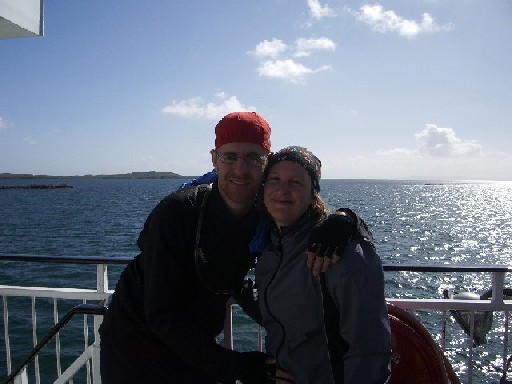Gracefully Straddling the Bolivia-Peru Border....
...Lake Titicaca that is - one of the worlds highest navigable lakes, perched at an altitude of 3820 metres and the place where according to ancient Incan legends the sun was born.
 Our tour of the lake began on the Bolivian side of the straddle, in the town of Copacabana. Here we met Lola. She was a showgirl...OK, we didn´t really, (Any Barry Manilow fans out there?) and it isn´t quite the hottest spot north of Havana either. We did however witness the rather curious "Blessing of the Automobiles". Punters in cars (decorated with flowers, ribbons and vodoo dolls) form an orderly line outside the dazzlingly white cathedral at 2pm every day. A monk dude then emerges from the inner sanctum and proceeds to bless the drivers and their vehicles, the ceremony culminating with a bottle of champagne being rather wastefully emptied over the bonnet.
Our tour of the lake began on the Bolivian side of the straddle, in the town of Copacabana. Here we met Lola. She was a showgirl...OK, we didn´t really, (Any Barry Manilow fans out there?) and it isn´t quite the hottest spot north of Havana either. We did however witness the rather curious "Blessing of the Automobiles". Punters in cars (decorated with flowers, ribbons and vodoo dolls) form an orderly line outside the dazzlingly white cathedral at 2pm every day. A monk dude then emerges from the inner sanctum and proceeds to bless the drivers and their vehicles, the ceremony culminating with a bottle of champagne being rather wastefully emptied over the bonnet. From Copa we journeyed out into the vast blueness of Lake Titicaca to the Isla del Sol (Island of the Sun). And spent 2 days soaking up the Sol, watching the Sol setting, exploring ancient Incan ruins, eating old trout and laughing at donkey´s heeeee-haaaws.
From Copa we journeyed out into the vast blueness of Lake Titicaca to the Isla del Sol (Island of the Sun). And spent 2 days soaking up the Sol, watching the Sol setting, exploring ancient Incan ruins, eating old trout and laughing at donkey´s heeeee-haaaws. To complete the tour of the lake we crossed into Peru and took a tour to the Uros Islands - incredible floating islands built entirely of reeds. The inhabitants of these unique islands live in reed houses with reed walls and reed roofs; they sit on reed chairs reading reed books at reed tables; use reed lavvies, and reed lavvie paper; worship in a reed church where a priest reads from a reed bible; they travel in a reed boats using reed oars, eat reeds, drink reeds and sleep reeds. Guess what these Reed Islanders sell to the reed-boat-loads of eager tourists? .....yeah, hotdogs.....OK they really sell handcrafted reed sundries.
To complete the tour of the lake we crossed into Peru and took a tour to the Uros Islands - incredible floating islands built entirely of reeds. The inhabitants of these unique islands live in reed houses with reed walls and reed roofs; they sit on reed chairs reading reed books at reed tables; use reed lavvies, and reed lavvie paper; worship in a reed church where a priest reads from a reed bible; they travel in a reed boats using reed oars, eat reeds, drink reeds and sleep reeds. Guess what these Reed Islanders sell to the reed-boat-loads of eager tourists? .....yeah, hotdogs.....OK they really sell handcrafted reed sundries.

























